Best 5 Stereoscopic Zoom Microscopes For Sale In 2022 Reviews
Are you interested in 3D microscopes?
Then please, keep reading!
In this post, I will tell you all you need to know about stereoscopic microscopes. You will learn what they are, and how they work. You’ll even be able to read a review on several such devices. With luck, this might even help you pick out the stereo zoom microscope you have been looking for.
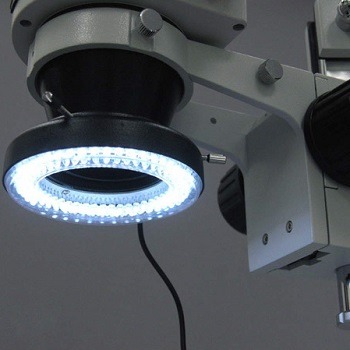
What Are Stereo Microscopes And How They Work?
What Kind Of Microscope Is It?
A stereoscopic microscope is also known as a stereo microscope or a dissecting microscope. It is a type of optical (light) microscope that produces a 3-dimensional visualization of the object you are observing. The image is perceived through a binocular viewing head. Also, unlike a regular microscope, it uses light which was reflected off the surface of the specimen, rather than passing through it.
How Is It Different From Others?
It is different from a regular compound microscope with a binocular head by the number of objectives through which the specimen is observed at one time. Regular (compound) microscope uses a single objective to produce a single image, whether it is on a monocular viewing head or binocular, in which case that same image is doubled and displayed in both eyepieces, that serve only for viewing comfort.
How Does It Work?
A stereo microscope has two objectives, set side by side so that the specimen is perceived from two different angles simultaneously. Each eyepiece shows a slightly different image, much like normal eyesight works in humans, and it overlaps in your mind as you observe it, creating a 3-dimensional image.
Why Is It Practical?
Thanks to the 3D image it produces, it enables the user to perform micro-operations, where a flat image would not be enough. It uses light that illuminates the specimen from the top and reflects off its surface. This, combined with the depth perception the dual objectives create, enables precise interaction with the specimen.
What Can It Be Used For?
Stereo zoom microscopes are also called dissecting microscopes because they enable dissection and operation on low magnification. That makes them perfect for entomology, for example. But they are also often applied in forensics, as well as in the production of watches, microchips and circuit boards, where they are used for manufacturing, inspecting, and quality control.
Best 5 Stereo Microscopes Reviews
Best Stereo Microscope For Entomology
Swift S41- 20x Dissecting Binocular Stereo Microscope
Special Features
The Swift dissecting stereo microscope is somewhat different than what you would expect from a microscope. It does not have a stage or a regular stand, but rather comes on a stand with a swiveling arm, which holds the device sideways. This allows you to position the device so that the objective at the bottom hovers over the object you are observing.
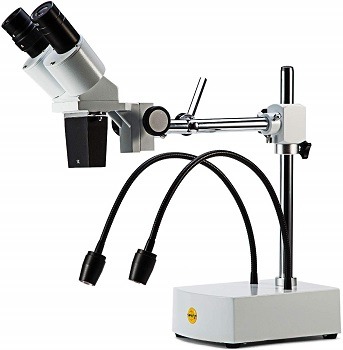
Practical Use
The aforementioned arm stand allows you to interact with the object of observation and work with your hands. Considering you can adjust the stereo microscope to hang just below your eye level, it leaves you with enough free space for maneuverability. That makes it the best tool for dissection and micro-operation, especially for entomology.
Design And Build
Swift stereo microscope weighs 15.8 pounds, and its dimensions are 15 x 8 x 16 inches. It is made fully out of metal, with a binocular viewing head, a stand with an arm that the device is mounted on, and two flexible long goose-neck LED lights, for convenient and precise illumination.
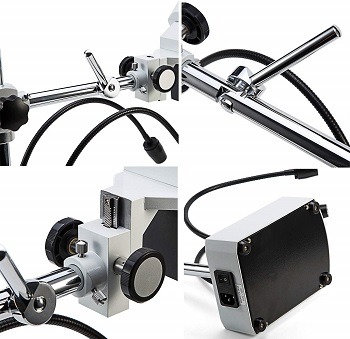
Magnification And Eyepieces
The binocular viewing head comes with one objective and two widefield wf10x and wf20x eyepieces. They are inclined at 45° and have diopter adjustable up to +/- 5dp, as well as the adjustable interpupillary distance from 2.2 to 3 inches. This microscope offers a magnification of 10x and 20x.
Stand And Arm Design
The Swift stereo 80 microscope has a base, a rod for adjusting the vertical height of the arm with a fastening knob, and the arm that sits at 90° angle and swivels 360°. The knob for adjusting focus sits on the side of the viewing head. Two long-necked LEDs protrude from the base and can be positioned to illuminate the object that is observed from any angle.
- 2 goose-necked LEDs
- swiveling arm
- adjustable height
- large working space
- made of metal
- one objective
- short magnification range
Best Trinocular Stereo Microscope
AmScope SM-4TZ Trinocular Stereo Zoom Microscope
Zoom Range
AmScope stereo microscope has a 0.7x – 4.5x zoom lens objective, which enables continuous zoom magnification, as well as longer focal length, which is useful for examining large specimens. This device comes with 2 Barrow lenses: the 0.5x Barlow lens for extending working distance, and the 2.0x lens that extends the device’s magnification range.
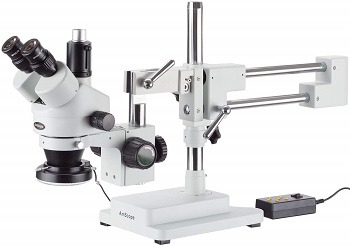
Microscope With Ring Light
Removable LED ring light serves as this stereo microscope’s light source. It is rheostat-controlled and has 144 bulbs in overall four separate zones. They can be controlled independently from each other (on the control box) in light intensity and direction. The ring has a 2.5 inch inside diameter and a4 inch outside diameter. The lights’ estimated life duration is about 100,000 hours.
Practical Stand
This stereo microscope boom stand is flexible yet stable, in the sense that it can be positioned to the height and length that suits your eye level. The range of adjustability is 20 inches vertical and 17 inches of width. This will leave your hands free to do any kind of work you wish to perform on the object you are observing.
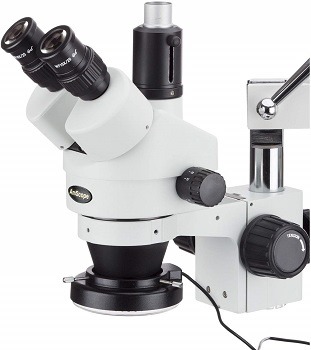
Useful As A Tool
AmScope microscope has a magnification range of 3.5x – 90x, which is among the more powerful and flexible stereo microscopes in this review. Combined with its adjustable double-arm boom stand, this device will enable you to perform your work or hobby without worrying about the microscope.
Additional Benefits
The extra benefit of having a trinocular microscope is that you can use the extra viewing port for and additional activity. For instance, that extra vertical eyepiece can be used as a C-mount or a 0.9-inch photo port. That means, if you want to take pictures or record as work, you can, but you will need to buy the camera separately.
- control box
- trinocular
- double-arm boom stand
- sturdy metal build
- changeable objective lens
- removable LED ring light
- heavy (61.5 pounds)
- no camera
- many moveable parts
Best Stereo Microscope For Soldering
Leica Microsystems A60 F Stereo Microscope
Handy Flex Arm Stand
This microscope’s dimensions are 14 x 6.8 inches. However, thanks to this multi-part arms stand, you can move it in any direction you like. The arm is comprised of 3 moving pieces and mounts on the table with a small clamp that takes up very little space.
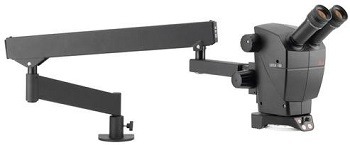
Great Maneuverability
The three arms are connected with flexible joints, 2 of which can be moved both vertically and in a 360° wide radius. This makes it the most versatile and most flexible arm stand among all the models in this review, probably among all microscopes.
Leica Fusion Optics Technology
With a working distance of 4.8 inches, you have comfortable access to the object you are observing, and the enhances optics give you a greater depth of field (compared to conventional stereo microscopes). This microscope’s magnification range is from 5x to 30x, and the eyepieces are set at a more comfortable, 38° angle.
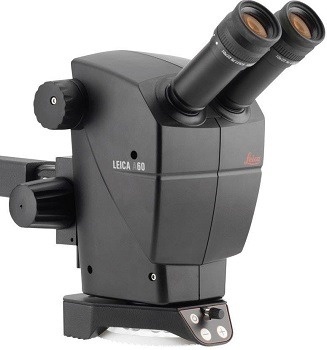
Time Saving Efficiency
Thanks to the greater depth of field, and a larger object field, you can see a larger area or a larger object, more accurately. This decreases the need to constantly adjust focus and distance, which saves you both time and effort. Combined with the great flex arm, the Leica stereo microscope is the perfect tool for soldering or any similar work.
LED Ring Light With Diffuser
The energy-saving LED ring light emits bright and color-neutral uniform light, and also comes with a removable diffuser. This can be used when working with highly reflective materials, to reduce strong light reflections.
- great flexible arm stand
- wide viewing field
- greater depth of field
- color-neutral LED light
- removable diffuser
- easy to operate
- different viewing angle
- not the best magnification range
- price
- needs space for arm maneuverability
Best Cheap 3D Stereo Microscope
National Geographic 20x Binocular Stereo Microscope
Portable And Light
This stereo microscope has a binocular viewing head, and a standard microscope design, meaning it has a base with a stage. It is therefore used to view samples, and not suited for observing large objects. The weight of the device is 1 pound, and the dimensions are 5.3 x 3.9 x 8.7 inches, which means it is easy to carry around.
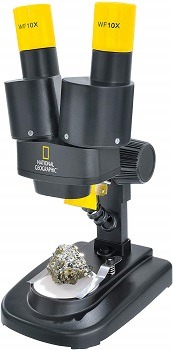
Easy And Simple To Use
National Geographic stereo microscope has magnification power up to 20x, which isn’t much but will suffice for simple observations. It is easy to use even by children, and its sleek and simple design means less breakable parts.
Battery-Operated LED Light
The incident LED illumination will enhance your sample-viewing experience, and the fact that the light is battery operated means you can even do that outdoors. The device is powered by 2 standard AA batteries, which are not included with the device but need to be bought separately.
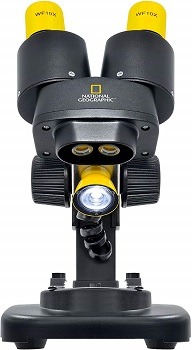
Attractive Design
This stereo microscope comes in a black color with yellow accents, which is a signature design feature for the National Geographic brand, whose logo is also highly visible at the front center of the device. Young explorers are sure to appreciate this color scheme.
Eyepieces
On the binocular viewing head, there is one pair of WF10x lenses, which create a 3D image, thanks to the 2 stereo lenses in the objective. The eyepieces have an individually adjustable interpupillary distance.
- portable
- cheap
- simple
- National Geographic design
- log magnification range
- needs batteries
- not rechargeable
- no adjustable diopter
Best Educational Stereo Microscope
Motic SFC-11 Stereo Microscope 20x-40x Zoom
Magnification Range And Availability
This Motic stereo microscope comes with an objective that has a magnification range from 20x-40x, but the objectives are also available in several other magnification range combinations. So, besides the 2x-4x objective, there are also the 1x-2x and the 1x-3x options.
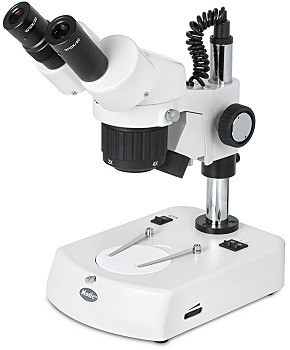
Viewing Head Description
The device has a binocular viewing head, set with 2 widefield eyepieces wf10x/0.8inch, at a 45° angle. The viewing head is 360°rotatable, and the coarse focus has adjustable tension. The working distance is 3.7 inches.
Base Stand
This microscope has a base stand that doubles as a flat stage with slide holders, similar to the previous model. From the stand stems a short vertical pole on which the head is mounted.
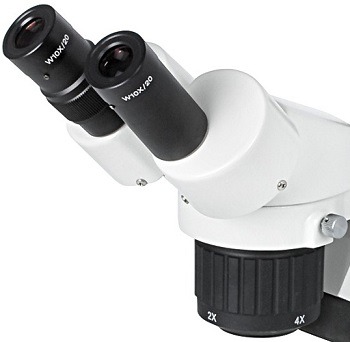
Dual Illumination
One thing that makes it stand out is the two different types of illumination with intensity control. There is the 15W incident, and the 10W transmitted halogen illumination. The on/off switches are on the top of the base, and the intensity control is located on the side of the base.
Purpose And Use
Motic stereo microscope comes with frosted glass stage plates, blue filter, and dust cover. Its design is simple, and it is easy to use. That makes it well-made for educational purposes, to use at schools or even at home.
- dual lighting
- easy to use
- simple design
- low magnification range
- coarse focus only
- device positioning
Conclusion: Which Stereo Microscope Models Are The Best?
In my opinion, the best two models are the Leica Microsystems A60 F, and the Swift S41- 20x Dissecting Microscope. The Swift binocular stereo microscope has 2 adjustable LED lights and a swiveling arm, which make it the best dissecting microscope for entomology. The Leica stereo microscope has a great flexible arm stand, which is useful for activities such as soldering. The Leica also has a wider and deeper viewing field, as well as a color-neutral LED ring light.
In case you want to find out more about available microscopes, you can read this post on which is the best microscope. If you are interested in other types of microscopes, feel free to take a look at this post on compound microscopes, and this post that talks about digital microscopes.
